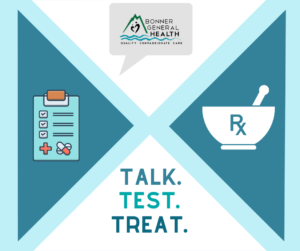
By Kathy Hubbard
“Less than 20 years ago, gonorrhea rates in the U.S. were at historic lows, syphilis was close to elimination, and advances in chlamydia diagnostics made it easier to detect infections,” said Raul Romaguera, DMD, MPH, acting director for CDC’s Division of Sexually Transmitted Diseases Prevention. “That progress has since unraveled, and our STD defenses are down. We must prioritize and focus our efforts to regain this lost ground and control the spread of STDs.”
Sexually transmitted diseases have serious health consequences. STDs, if untreated, can cause chronic pelvic pain, pelvic inflammatory disease, infertility, severe pregnancy, newborn complications, and infant death. In addition, having an STD can increase your risk for HIV infection.
And, if you don’t think the thirty percent increase in the top three diseases, syphilis, gonorrhea, and chlamydia, is happening here in the Inland Northwest, think again. An article written by Chanse Watson, Hagadone News Network, and published in the Daily Bee on April 4 quoted Panhandle Health District Public Information Officer Katherine Hoyer as saying that the cases of syphilis alone have doubled in the area in the last three months over the last year.
“We want to encourage those that want to engage in sexual activity to be safe about it – wear a condom and get tested regularly if you’re engaging with multiple partners,” she said. Hoyer credited online dating apps as a “contributing factor” for the increase in syphilis cases
We can talk about gonorrhea and chlamydia another day. Today we’ll focus on syphilis because it’s the STD close to becoming eradicated in the U.S. twenty years ago. So we ask, why the rise? Can we really blame dating apps?
“There are many factors that could be contributing to the rise of syphilis rates, GoodRx Health says, “decreased public health funding and resources for STD clinics; a decrease in condom use with the development of medications that can prevent HIV transmission; lack of prenatal care; and a shift of people who used to work in syphilis and STDs now focusing on the COVID-19 pandemic.
They also said that syphilis reinfections may have fewer symptoms which makes it harder to diagnose. As for the dating apps, GoodRx says their increase in popularity makes it more difficult to track the spread of disease and harder to notify people who may be infected.
The National Library of Medicine tells us that the bacterium that causes syphilis, treponema pallidum, has been around forever. The name syphilis was applied in the sixteenth century.
“From the very beginning, syphilis has been a stigmatized, disgraceful disease; each country whose population was affected by the infection blamed the neighboring countries for the outbreak. So, the inhabitants of today’s Italy, Germany, and the United Kingdom named syphilis ‘the French disease,’ the French named it the ‘Neapolitan disease,’ the Russians called it ‘Polish disease,’ the Polish named it the ‘German disease,’ the Danish, the Portuguese and the inhabitants of Northern Africa named it ‘the Spanish/Castilian disease’ and the Turks coined the term ‘Christian disease.’”
In Northern India, the Muslims blamed the Hindu for syphilis and, of course, the Hindu blamed the Muslims, and in the end, everyone blamed the Europeans. And we’re challenged with contact tracing today!
Now, thanks to the discovery of penicillin, the disease, if caught at its early stages, can be cured with a simple shot. However, not discovered early, the bacteria can remain inactive in the body for decades before becoming active again.
Mayo Clinic says the first sign of syphilis is a small sore called a chancre (SHANG-kur). “The sore appears at the spot where the bacteria entered your body. Many people who have syphilis don’t notice the chancre because it’s usually painless, and it may be hidden within the vagina or rectum. The chancre will heal on its own within three to six weeks.”
Within a few weeks, the infected person may experience a rash that begins on the trunk but soon spreads especially on the palm of the hands and bottoms of the feet. Other signs include difficulty with balance, sudden vision changes, or numbness in toes, feet, or legs.
Remember, you aren’t just having sex with your partner. You’re having sex with everyone your partner ever had sex with. So use a condom, get tested regularly, and let’s eradicate this disease.
Kathy Hubbard is a member of the Bonner General Health Foundation Advisory Council. She can be reached at kathyleehubbard@yahoo.com.

